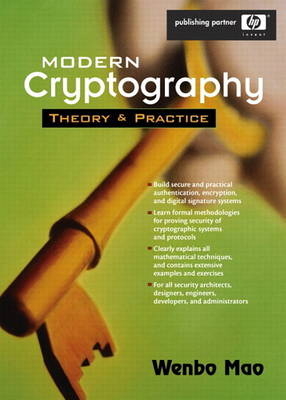
Modern Cryptography
Prentice Hall (Verlag)
978-0-13-288741-0 (ISBN)
- Titel ist leider vergriffen;
keine Neuauflage - Artikel merken
Modern Cryptography is an indispensable resource for every advanced student of cryptography who intends to implement strong security in real-world applications. Leading HP security expert Wenbo Mao explains why conventional crypto schemes, protocols, and systems are profoundly vulnerable, introducing both fundamental theory and real-world attacks. Next, he shows how to implement crypto systems that are truly “fit for application,” and formally demonstrate their fitness. He begins by reviewing the foundations of cryptography: probability, information theory, computational complexity, number theory, algebraic techniques, and more. He presents the “ideal” principles of authentication, comparing them with real-world implementation. Mao assesses the strength of IPSec, IKE, SSH, SSL, TLS, Kerberos, and other standards, and offers practical guidance on designing stronger crypto schemes and using formal methods to prove their security and efficiency. Finally, he presents an in-depth introduction to zero-knowledge protocols: their characteristics, development, arguments, and proofs. Mao relies on practical examples throughout, and provides all the mathematical background students will need.
WENBO MAO, PhD, is a Technical Contributor to the Trusted Systems Lab at Hewlett-Packard Laboratories, Bristol, UK. Mao leads HP's participation and research activities in Computer Aided Solutions to Secure Electronic Commerce Transactions (CASENET), a research project funded by the European Union. His research interests include cryptography, computer security, and formal methods. He is a member of the International Association for Cryptographic Research (IACR), the Institute of Electrical and Electronics Engineers (IEEE), and the British Computer Society (BCS).
A Short Description of the Book.
Preface.
List of Figures.
List of Algorithms, Protocols and Attacks.
I. INTRODUCTION.
1. Beginning with a Simple Communication Game.
A Communication Game. Criteria for Desirable Cryptographic Systems and Protocols. Chapter Summary. Exercises.
2. Wrestling between Safeguard and Attack.
Introduction. Encryption. Vulnerable Environment (the Dolev-Yao Threat Model). Authentication Servers. Security Properties for Authenticated Key Establishment. Protocols for Authenticated Key Establishment Using Encryption. Chapter Summary. Exercises.
II MATHEMATICAL FOUNDATIONS.
Standard Notation.
3. Probability and Information Theory.
Introduction. Basic Concept of Probability. Properties. Basic Calculation. Random Variables and their Probability Distributions. Birthday Paradox. Information Theory. Redundancy in Natural Languages. Chapter Summary. Exercises.
4. Computational Complexity.
Introduction. Turing Machines. Deterministic Polynomial Time. Probabilistic Polynomial Time. Non-deterministic Polynomial Time. Non-Polynomial Bounds. Polynomial-time Indistinguishability. Theory of Computational Complexity and Modern Cryptography. Chapter Summary. Exercises.
5. Algebraic Foundations.
Introduction. Groups. Rings and Fields. The Structure of Finite Fields. Group Constructed Using Points on an Elliptic Curve. Chapter Summary. Exercises.
6. Number Theory.
Introduction. Congruences and Residue Classes. Euler's Phi Function. The Theorems of Fermat, Euler and Lagrange. Quadratic Residues. Square Roots Modulo Integer. Blum Integers. Chapter Summary. Exercises.
III. BASIC CRYPTOGRAPHIC TECHNIQUES.
7. Encryption—Symmetric Techniques.
Introduction. Definition. Substitution Ciphers. Transposition Ciphers. Classical Ciphers: Usefulness and Security. The Data Encryption Standard (DES). The Advanced Encryption Standard (AES). Confidentiality Modes of Operation. Key Channel Establishment for Symmetric Cryptosystems. Chapter Summary. Exercises.
8. Encryption—Asymmetric Techniques.
Introduction. Insecurity of “Textbook Encryption Algorithms”. The Diffie-Hellman Key Exchange Protocol. The Diffie-Hellman Problem and the Discrete Logarithm Problem. The RSA Cryptosystem (Textbook Version). Cryptanalysis Against Public-key Cryptosystems. The RSA Problem. The Integer Factorization Problem. Insecurity of the Textbook RSA Encryption. The Rabin Cryptosystem (Textbook Version). Insecurity of the Textbook Rabin Encryption. The ElGamal Cryptosystem (Textbook Version). Insecurity of the Textbook ElGamal Encryption. Need for Stronger Security Notions for Public-key Cryptosystems. Combination of Asymmetric and Symmetric Cryptography. Key Channel Establishment for Public-key Cryptosystems. Chapter Summary. Exercises.
9. In an Ideal World: Bit Security of the Basic Public-Key Cryptographic Functions.
Introduction. The RSA Bit. The Rabin Bit. The ElGamal Bit. The Discrete Logarithm Bit. Chapter Summary. Exercises.
10. Data Integrity Techniques.
Introduction. Definition. Symmetric Techniques. Asymmetric Techniques I:Digital Signatures. Asymmetric Techniques II: Data Integrity without Source Identification. Chapter Summary. Exercises.
IV. AUTHENTICATION.
11. Authentication Protocols—Principles.
Introduction. Authentication and Refined Notions. Convention. Basic Authentication Techniques. Password-based Authentication. Authenticated Key Exchange Based on Asymmetric Cryptography. Typical Attacks on Authentication Protocols. A Brief Literature Note. Chapter Summary. Exercises.
12. Authentication Protocols—The Real World.
Introduction. Authentication Protocols for Internet Security. The Secure Shell (SSH) Remote Login Protocol. The Kerberos Protocol and its Realization in Windows 2000. SSL and TLS. Chapter Summary. Exercises.
13. Authentication Framework for Public-Key Cryptography.
Introduction. Directory-Based Authentication Framework. Non-Directory Based Public-key Authentication Framework. Chapter Summary. Exercises.
V. FORMAL APPROACHES TO SECURITY ESTABLISHMENT.
14. Formal and Strong Security Definitions for Public-Key Cryptosystems.
Introduction. A Formal Treatment for Security. Semantic Security—the Debut of Provable Security. Inadequacy of Semantic Security. Beyond Semantic Security. Chapter Summary. Exercises.
15. Provably Secure and Efficient Public-Key Cryptosystems.
Introduction. The Optimal Asymmetric Encryption Padding. The Cramer-Shoup Public-key Cryptosystem. An Overview of Provably Secure Hybrid Cryptosystems. Literature Notes on Practical and Provably Secure Public-key Cryptosystems. Chapter Summary. Exercises.
16. Strong and Provable Security for Digital Signatures.
Introduction. Strong Security Notion for Digital Signatures. Strong and Provable Security for ElGamal-family Signatures. Fit-for-application Ways for Signing in RSA and Rabin. Signcryption. Chapter Summary. Exercises.
17. Formal Methods for Authentication Protocols Analysis.
Introduction. Toward Formal Specification of Authentication Protocols. A Computational View of Correct Protocols—the Bellare-Rogaway Model. A Symbolic Manipulation View of Correct Protocols. Formal Analysis Techniques: State System Exploration. Reconciling Two Views of Formal Techniques for Security. Chapter Summary. Exercises.
VI. CRYPTOGRAPHIC PROTOCOLS.
18. Zero-Knowledge Protocols.
Introduction. Basic Definitions. Zero-knowledge Properties. Proof or Argument? Protocols with Two-sided-error. Round Efficiency. Non-interactive Zero-knowledge. Chapter Summary. Exercises.
19. Returning To “Coin Flipping over Telephone”.
Blum's “Coin-Flipping-by-Telephone” Protocol. Security Analysis. Efficiency. Chapter Summary.
20.Afterremark.
Bibliography. Subject Index.
| Erscheint lt. Verlag | 7.11.2011 |
|---|---|
| Verlagsort | Upper Saddle River |
| Sprache | englisch |
| Maße | 178 x 233 mm |
| Gewicht | 1170 g |
| Themenwelt | Mathematik / Informatik ► Informatik ► Datenbanken |
| Informatik ► Netzwerke ► Sicherheit / Firewall | |
| Informatik ► Theorie / Studium ► Kryptologie | |
| ISBN-10 | 0-13-288741-X / 013288741X |
| ISBN-13 | 978-0-13-288741-0 / 9780132887410 |
| Zustand | Neuware |
| Haben Sie eine Frage zum Produkt? |
aus dem Bereich


